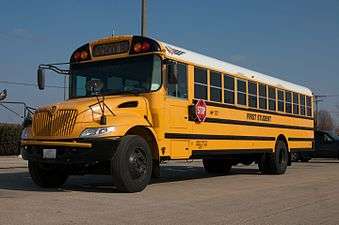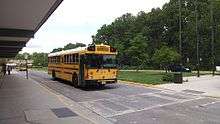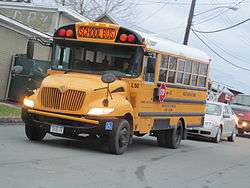IC Bus
 IC Bus corporate logo | |
| Subsidiary of Navistar International | |
| Industry | Manufacturing (Transportation) |
| Predecessor | |
| Founded | 2002 (as IC Corporation) |
| Headquarters |
2601 Navistar Dr Lisle, Illinois 60532 |
Number of locations |
2
|
Area served | North America |
Key people | John McKinney, President |
| Products |
|
| Parent | Navistar International |
| Website | ICBus.com |
IC Bus (originally IC Corporation) is an American bus manufacturer that produces yellow school buses and commercial-use buses (shuttle buses) primarily for the United States and Canada, with limited exports outside of North America. Headquartered in Lisle, Illinois, IC is a wholly owned subsidiary of Navistar International. The company was established by Navistar in 2002 through a reorganization of its subsidiary bus manufacturer American Transportation Corporation (AmTran). Through AmTran, IC traces its roots back to the 1933 founding of Ward Body Works in Conway, Arkansas.
The IC company name stands for Integrated Coach (originally Integrated Chassis), alluding to how the vehicles are nearly completely assembled under a single corporate structure. For all IC vehicles, Navistar produces the bus body, chassis, and engine. Currently, all IC Bus vehicles are produced at its manufacturing facility in Tulsa, Oklahoma; since 2010, the former AmTran/Ward manufacturing facility in Conway, Arkansas has remained in use for fabrication and the production of parts.
History

2000s: AmTran to IC

The transition of the bus manufacturing subsidiary of Navistar began in 2000 as AmTran introduced a new-generation cowled-chassis conventional. While still based upon the International 3800 and sharing much of the body with its AmTran Volunteer/CS predecessor, the new bus featured a redesigned drivers compartment and larger windshield. The new bus was given the International IC name (IC standing for Integrated Coach/Chassis), the model emphasized how the entire vehicle (body, chassis, engine) was produced under a single corporate entity. To distinguish the IC from other Type C buses sharing the International 3800 chassis, the IC was given its own grille and hood badging.
After 2000, AmTran Corporation changed its name to International Truck and Bus, bringing it in line with the truck manufacturing division of Navistar (then International Truck and Engine); the AmTran FE and AmTran RE model lines adopted the International brand name and badging. For 2003, International re-branded its bus subsidiary to IC Corporation. After a minor update, the International IC was rebranded the IC CE-Series, in line with the FE and RE-Series buses.
In the mid-2000s, IC saw a number of changes. As Navistar introduced its first all-new cowled chassis since 1979 with the International 3300 (a cowled-chassis variant of the International 4300/Durastar), IC introduced a new-generation CE-Series in 2005. In 2006, the BE-Series was a second IC-bodied bus based on the 3300; although similar in configuration to the CE, the flat-floor low-profile BE was designed for users of smaller buses; its highest capacity was 30 passengers.
While the commercial products of Ward/AmTran had been strictly derived from variants of their school bus bodies, in 2006, IC launched two all-new product ranges for commercial, paratransit, and shuttle bus customers. In addition to commercial variants of the BE, CE, and RE, IC launched two cutaway-cab product lines based on the International Durastar. The HC-Series was a range of shuttle buses while the LC-Series was a low-floor bus aimed at paratransit customers.
In April 2009, IC Corporation changed its name to IC Bus.
2010s: Product adaptation
2010 marked a major transition of the IC product line. In a single year, the company ended production of one of its highest-capacity vehicles while making an introduction of its first small school bus. The FE-Series was removed from the IC product line, as dealers announced its discontinuation in April and the company removed its product literature from the IC Bus website. Subsequently, the only Type D bus in the IC product line is the rear-engine RE-Series. The International TerraStar Class 4/5 truck formed the basis of two new model lines introduced by the company. The AC-Series was introduced as a commercial shuttle bus (competing against van-based buses), while the AE-Series became the first cutaway-cab school bus produced by the company since the discontinuation of the AmTran Vanguard in 1996.
In the mid-2010s, IC Bus underwent changes to stabilize its model line. To re-emphasize the ties to its parent company, IC Bus modified its branding in 2013, adding the Navistar script to its IC Bus "wing" logo. To better focus on its core model lines, the AE/AC-Series, BE-Series, and LC-Series were discontinued in 2014. Currently (as of the 2017 model year, the CE and RE-Series school buses/MFSABs and commercial derivatives are produced alongside the HC-Series commercial shuttle bus (based on the Durastar truck).[1]
In response to the controversial EGR emissions strategy of Navistar, the MaxxForce engines were phased out in the CE-Series, with the Cummins ISB6.7 essentially taking the place of both previous diesel engines after being introduced as an option.[2] In 2015, IC debuted its first alternative-fuel vehicle, showing a propane-powered CE-Series with a PSI 8.8L V8 engine.[3] In 2016, the same engine was introduced in a gasoline-fueled configuration.[4]
Products
School/commercial buses
- Model designations
Prior to 2010, IC used the following nomenclature (on school buses) to designate the engine type; subsequently, only the model prefix has been used.
| Diesel Engine Configuration | BE-Series | CE-Series | FE-Series | RE-Series |
|---|---|---|---|---|
| V8
(i.e. T444E, VT365, MF7) |
BE200 | CE200 | RE200 | |
| Inline-6
(i.e. DT466, MFDT) |
CE300 | FE300 | RE300 |
| IC Bus Product Line (School Buses) | |||||||||||||||
|---|---|---|---|---|---|---|---|---|---|---|---|---|---|---|---|
| Model Name | Production Date | Assembly Location | Chassis Configuration
(Chassis Model) |
Vehicle type | Seating Capacity | Notes | |||||||||
| AE-Series AC-Series
|
2010–2015 | Tulsa, Oklahoma | Cutaway cab/chassis |
|
36 (AE-Series) 31 (AC-Series) |
| |||||||||
| BE-Series
|
2006–2015 | Cowled chassis |
|
14-30 |
| ||||||||||
| CE-Series
|
2001–present | Cowled chassis
International 3800 (2001-2004) (2005-present) |
|
29-77 (school bus/MFSAB)
52 (commercial bus) |
| ||||||||||
| FE-Series
|
1990-2010 | Conway, Arkansas | Front-engine stripped chassis | School bus (Type D) |
54-90 |
| |||||||||
| RE-Series RC-Series
|
1996–present | Conway, Arkansas
|
Rear-engine stripped chassis |
|
|
| |||||||||
| IC Bus Product Line (Commercial Buses) | |||||||||||||||
| Model Name | Production Date | Assembly Location | Chassis Configuration
(Chassis Model) |
Vehicle Type | Seating Capacity | Notes | |||||||||
| LC-Series | 2006-2014 | Tulsa, Oklahoma | Cutaway cab/chassis | Low-floor shuttle bus |
| ||||||||||
| HC-Series
|
2006–present | Cutaway cab/chassis |
|
|
| ||||||||||
Forward Advantage Prototype
The IC FE Forward Advantage was a school bus prototype built by IC in 2008 as a testbed of a "flat-floor" design in the stepwell due to the compact design of the Caterpillar C7 engine. It also included some front-end styling modifications influenced by the severe-service line of International trucks. As Caterpillar has withdrawn from producing diesel engines for the school bus market, the Forward Advantage will not see production in its current form since its design was tailored to the Caterpillar engine.
Hybrid diesel-electric buses
IC offers hybrid diesel-electric powertrains in the CE conventional school bus as an option. The buses provide approximately 40% better fuel economy but cost about two and a half times more than a standard diesel bus ($210,000 versus $80,000).[7] Enova Systems[8] has entered into a long-term supply agreement with IC Bus[9] that guarantees that Enova’s proprietary Post Transmission Parallel Hybrid Electric drive system will be used in IC Bus’ hybrid electric school buses. The hybrid school bus project features Enova’s charge depleting (or “plug-in”) or charge-sustaining systems. The drivetrain is powered by Valence Technology lithium ion phosphate battery modules. The braking system utilizes regenerative braking both as a means to reduce wear on the service brakes and to supply the batteries with extra power.[10]
Motorcoach prototypes
At the 2008 American Public Transportation Association Expo trade show, Navistar announced its intention to enter the intercity motorcoach segment by 2010, unveiling two prototypes produced by IC Bus.[11] Using the MaxxForce 13 powerplant, IC Bus produced a 40-foot long prototype alongside a 45-foot prototype. Using wind-tunnel design, the company predicted similar fuel-efficiency gains that were seen with the streamlined International ProStar semitractor.[11]
Following the two prototypes, IC Bus abandoned its efforts in the motorcoach segment, concentrating its commercial buses on school bus derivatives and the HC-Series (a cutaway variant of the International DuraStar).
Assembly
All IC Corporation/IC Bus vehicles are produced in the Tulsa, Oklahoma, facility opened by AmTran in 1999. Prior to 2008, Type D models were produced in the Ward/AmTran facility in Conway, Arkansas. On January 11, 2008, IC Corporation announced a layoff of about 300 employees at the Conway, Arkansas Bus Plant.[12] This was just under the maximum number of employees that could be laid off in Conway without the company violating the WARN Act, which requires employers to give 60 days notice of a mass layoff or plant closing. In addition to the layoffs, the company also announced a 50 percent reduction in bus production at the Conway plant. IC Corp. officials cited a lack of new orders as the reason for the layoffs. However,the company had recently announced increased production at the plant in Tulsa, Oklahoma. This stoked fears in Conway that the company was planning to shut down the plant in the near future and move all production to the newer, and non-union, Tulsa plant.
On November 5, 2009, IC Bus announced that its Conway plant would no longer assemble buses after January 18, 2010, projecting elimination of 477 jobs. The Conway facilities will serve as fabrication shops and will manufacture parts, but will no longer produce complete buses. The company cited low demand by school districts and contractors during the recessionary economic climate in the United States.[13] "We have to consolidate our bus-assembly operations into one facility," Navistar spokesman Roy Wiley said. "Unfortunately for Conway, Tulsa is a much newer facility."[14]
On June 5, 2012, the Tulsa, Oklahoma IC Bus assembly plant produced its 100,000th vehicle. The Tulsa Bus Plant employs more than 1,200 dedicated workers who manufacture, on average, 50 to 75 buses a day. This number has grown significantly from 400 employees when the plant first opened in 2001. "This plant demonstrates our commitment to the school bus industry by building quality, state-of-the-art product," said John McKinney, president of Navistar Global Bus and IC Bus. "Because of the hard work and dedication of our Tulsa employees, IC Bus is far and away the industry leader not only in pure sales volume, but more importantly in product quality." The 100,000th bus marks more than just a milestone, but a testament to IC Bus' commitment to the community. The Tulsa bus plant contributes to the current growth trend of manufacturing in the U.S., which is illustrated by the more than 1,200 local skilled and office workers there.[15]
See also
- AmTran - corporate predecessor
- Navistar International - parent company
References
- ↑ "ICBus - IC Bus - Leading School Bus Manufacturer". IC Bus. Retrieved 2016-03-09.
- ↑
- ↑ "IC Bus Introducing Propane CE Series School Bus by Fall 2015". Stnonline.com. Retrieved 2016-03-09.
- ↑ "IC Bus Unveils Gasoline-Powered Type C School Bus". School Bus Fleet. Retrieved 11 September 2016.
- ↑ https://web.archive.org/web/20110713001841/http://www.icbus.com/ICBus/Buses/School+Route/Feature/ci.School+Route+AE+Series.feature/. Archived from the original on July 13, 2011. Retrieved November 6, 2010. Missing or empty
|title=(help) - 1 2 "ICBus - IC Bus - Leading School Bus Manufacturer". IC Bus. Retrieved 2016-03-09.
- ↑ https://web.archive.org/web/20070929102710/http://www.advancedenergy.org/corporate/initiatives/heb/phase4.php. Archived from the original on September 29, 2007. Retrieved February 19, 2007. Missing or empty
|title=(help) - ↑ "Enova | Electric, Hybrid Electric and Fuel Cell Drive Systems". Enovasystems.com. 2011-12-31. Retrieved 2016-03-09.
- ↑ "Enova Systems and IC Bus Execute Long Term Agreement For Hybrid School Buses". Green Car Congress. 2008-05-20. Retrieved 2016-03-09.
- ↑ (PDF) https://web.archive.org/web/20101231211526/http://www.icbus.com/ICCorp/BusDownloads/School%20Route/CE%20Series%20Hybrid%20Sell%20Sheet.pdf. Archived from the original (PDF) on December 31, 2010. Retrieved April 26, 2010. Missing or empty
|title=(help) - 1 2 "IC Bus Announces Plans to Enter Motorcoach Market in 2010 (NYSE:NAV)". ir.navistar.com. Retrieved 2016-09-26.
- ↑ "Conway school-bus maker to lay off 300". Arkansasonline.com. 2008-01-11. Retrieved 2016-03-09.
- ↑
- ↑
- ↑ "Navistar Celebrates 100,000th Bus Milestone (NYSE:NAV)". Ir.navistar.com. 2012-06-05. Retrieved 2016-03-09.
External links
- ICBus.com - official company web site
 Media related to IC Bus school buses at Wikimedia Commons
Media related to IC Bus school buses at Wikimedia Commons


.jpg)


